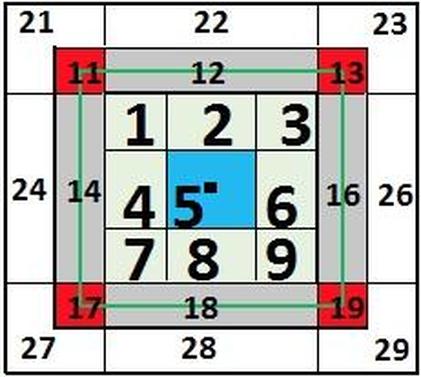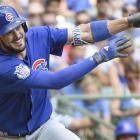In all likelihood Vladimir Guerrero will be inducted into the National Baseball Hall of Fame next summer. He was on the ballot for the first time last year, when he appeared on 71.7 percent of submitted ballots, just short of 75 percent needed for induction. Vlad was only 15 votes short of being voted into Cooperstown.
Historically, when a player receives over 70 percent of the vote but does not get the 75 percent necessary for induction, they get over the hump the following year. That figures to happen with Guerrero this year. He'll get into Cooperstown based on his tremendous five-tool ability, as well as his ability to hit any pitch, no matter where it was thrown. For example:
I'm not sure there's been a better "bad-ball" hitter in baseball over the last 30 years or so. Vlad could hit anything. He retired as a career .318/.379/.553 (140 OPS+) hitter with 449 home runs. That includes a .327/.394/.586 (151 OPS+) batting line during his peak from 1998-2007. Guerrero was a nightmare for opposing pitchers; he didn't have a hole in his swing.
Being a bad-ball hitter is an innate skill. You're either born with the ability to hit anything anywhere, or you're not. No one practices it. No one works on hitting pitches way out of the zone. They work on recognizing those pitches and taking them for balls to get into more favorable hitter's counts. Most guys with Vlad's approach, that "swing at whatever and it'll work out" mentality, never make the majors. They aren't talented enough to pull it off.
There is definite value in being a bad-ball hitter, as unconventional as it may be. Doing damage on a pitch out of the zone will annoy pitchers, first of all, but it'll also make them feel uncomfortable on the mound. They'll feel like there's nowhere to pitch someone who is a quality bad-ball hitter.
So, who were the best bad-ball hitters in baseball this season? That's what we're here to find out.
To do that, we must first define a "bad ball." For the purposes of this exercise, I'm going with pitches well out of the strike zone. Baseball Savant, the intimidatingly great Statcast resource, allows us to look at pitches in specific zones in and around the strike zone. Here is their "detailed strike zone" map:

We're going to focus on pitches in Zones 21, 22, 23, 24, 26, 27, 28, 29. (There is no Zone 25, since Zone 5 is in the middle of the strike zone and the counting mechanism goes outward from the other eight zones.) Pitches in those locations are our "bad balls." Those are the pitches hitters should not swing at, but sometimes do. And sometimes they do damage on pitches in those locations. Some are better at it than others.
Let's dive into the bad ball stats for the 2017 season (min. 50 bad balls in play).
Batting Average
- Kris Bryant, Cubs: .268
- Eduardo Nunez, Giants/Red Sox: .250
- Dee Gordon, Marlins: .247
- Jose Altuve, Astros: 223
- Brian Dozier, Twins: .222
(Worst: Joey Gallo, Rangers: .000 on 53 balls in play)
I expected Nunez or Altuve to be atop the bad-ball batting average leaderboard before I ran the search, so I'm glad to see they're in the top five. My assumptions based on watching an embarrassing amount of baseball each season were at least in the ballpark.
Anyway, the league batting average on bad balls (as per our definition) was only .114. That's all. Hitting .268 overall is okay. Hitting .268 on bad balls like Bryant did this year is amazing. He was far ahead of Nunez. In fact Bryant, Nunez, and Gordon were sort of in a league of their own when it came to hitting for average on bad balls in 2017. Only eight players hit .200 or better on bad balls this year.
Slugging Percentage
- Kris Bryant, Cubs: .423
- Justin Upton, Tigers / Angels: .423
- Brian Dozier, Twins: .378
- Trey Mancini, Orioles: .317
- Mark Trumbo, Orioles: .316
(Worst: Gallo at .000)
Once again, we have a very clearly defined top tier here. There's Bryant and Upton, a big gap down to Dozier, then a big gap down to everyone else. Only six players slugging .300 or better on bad balls this season. (Eddie Rosario of the Twins was the sixth.) The league average slugging percentage on bad balls in 2017? A mere .148. Pitchers slugged .161 this year, for reference.
Weighted on-base average (wOBA)
- Kris Bryant, Cubs: .500
- Justin Upton, Tigers/Angels: .455
- Edwin Encarnacion, Indians: .443
- Freddie Freeman, Braves: .428
- Christian Yelich, Marlins: .428
(Worst: Javier Baez, Cubs: .135)
wOBA is essentially a souped-up version of on-base percentage. A hit is not equal to a walk, as on-base percentage says. A double is not the same thing as two singles. Stuff like that is properly accounted for in wOBA, which is scaled to regular old on-base percentage. A .400 wOBA is great. A .300 wOBA is pretty bad.
The league average wOBA on bad balls was .332 this season, so our five heroes are roughly 100 points better than average. Eight others bested a .400 wOBA on bad balls in 2017, including Dozier, who also popped up on our batting average and slugging percentage leaderboards. Based on that, it's safe to call him one of the top bad-ball hitters in the game.
Expected weighted on-base average (xwOBA)
- Edwin Encarnacion, Indians: .462
- Todd Frazier, White Sox / Yankees: .432
- Kris Bryant, Cubs: .427
- Eugenio Suarez, Reds: .420
- Steven Souza, Rays: .420
(Worst: Baez at .126)
xwOBA tells us what a player was expected to hit based on the batted ball's exit velocity and trajectory. We've all seen that well-struck line drive right at an infielder for an out. It happens. xwOBA credits the hitter for that well-struck ball (or docks him for a poorly struck ball) and says "this is what you should have hit." In theory, you can compare wOBA to xwOBA to find the luckiest and unluckiest hitters in baseball.
The league average on bad balls was a .325 xwOBA this year -- again, it's on the same scale as regular old on-base percentage -- and 13 players total topped a .400 xwOBA. Encarnacion was far ahead of everyone else in this metric. He made consistently great contact on pitches well out of the zone. And, once again, Bryant makes the top five. He's the only player to make all four of our leaderboards -- he's No. 1 on three and No. 3 on the other, which is pretty impressive -- so I think we can hand him the title of "MLB's best bad-ball hitter of 2017."


















